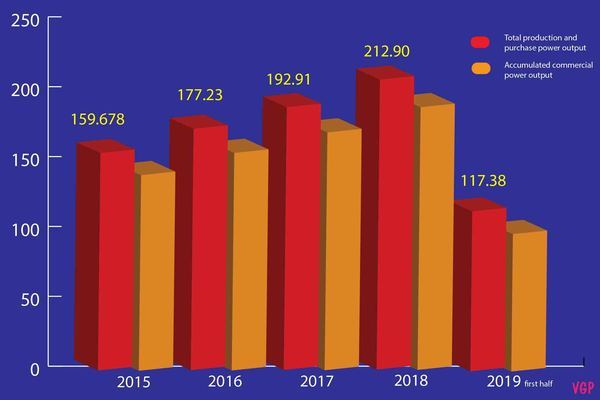 |
|
Power production and purchase output and power consumption from 2015-2019. Unit: Billion kWh
|
The EVN reported that the total production and purchase power output climbed 10.6% to 117.38 billion kWh in the first half of 2019, of which coal-fired thermal power rose by 24.7% and hydropower decreased by 8.86%.
The EVN had to mobilized oil to generate 732 million kWh to ensure power supply in the reviewed period. Meanwhile, accumulated commercial power output in the first six month was estimated at 100.95 billion kWh, or a year-on-year increase of 10.01%, of which domestic commercial power output picked up 9.5%.
By the end of 2018, the EVN had supplied power to all communes and about 99.37% households could access to electricity.
As power shortage is deemed to take place in the coming years, last month, the Government tasked inferior levels to quicken construction of 9 power projects to secure power supply until 2025.
The urgent power projects are Quang Trach I, Quang Trach II, Dung Quat I, Dung Quat II, O Mon III and O mom IV, and expansion of Hoa Binh, Yaly, and Tri An hydropower plants.
In its latest resolution, the Government fixed deadlines for commercial operation of the Song Hau 1 coal-fired power plant and the Thai Binh 2 coal-fired power plant. Accordingly, the Ministry of Industry and Trade was asked to put the first and the second turbine generator of the Song Hau 1 coal-fired power plant into operation in the second and third quarter of 2021, respectively.
The ministry was also requested to ensure that the first and the second turbine generator of the Thai Binh 2 coal-fired power plant will come into operation by December 2020 and the first quarter of 2021, respectively.
Earlier in July this year, Prime Minister Nguyen Xuan Phuc had tasked the Ministry of Industry and Trade to review a media report saying many solar power plants are operating under capacity due to national grid overload.
Viet Nam witnessed a boom in construction of solar power plants thanks to the introduction of the Prime Minister’s Decision No.11/2017/QD-TTg on mechanisms to encourage the development of solar power projects.
Under the decision, all solar power plants across the country shall enjoy a feed-in tariff (FIT) of 9.35 cents per kilowatt-hour for a period of 20 years if they begin commercial operation before June 30, 2019.
In the first six months of 2019, nearly 90 plants with the combined design capacity of approximately 4,500 MW were connected to the national grid, accounting for 10% of the national total capacity.
One of the biggest challenges for the power sector is to implement transmission projects to absorb designed power capacity of solar power plants as this process averagely takes about 3-5 years. VGP
 The power demand is estimated to increase by 9.9% this year, according to the Electricity of Vietnam (EVN).
The power demand is estimated to increase by 9.9% this year, according to the Electricity of Vietnam (EVN).